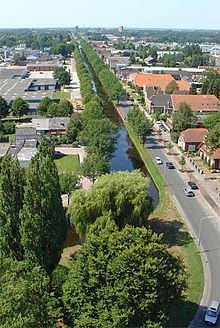
Ribbon development refers to the building of houses along the routes of communications radiating from a human settlement. The resulting linear settlements are clearly visible on land use maps and aerial photographs, giving cities and the countryside a particular character.[1] Such development generated great concern in the United Kingdom during the 1920s[2] and the 1930s as well as in numerous other countries during the decades since.
Normally the first ribbons are focused on roads. Following the Industrial Revolution, ribbon development became prevalent along railway lines, predominantly in Russia, the United Kingdom, and the United States. However, the investment required to build railway stations, the ensuing attractiveness of easy rail access, and need for accompanying roads often led to new small settlements outside of the center city. Ribbon developments yielded attractive home locations on isolated roads as increasing motor car ownership meant that houses could be sold easily even if they were remote from workplaces and urban centres. Developers were pleased to not have to construct additional roads, thereby saving money and plot space. Ribbon developments also filled spaces at the interstice between urban areas, and resultingly appealed to potential buyers needing to access one or more of these locations.
The extent of this development practice around roads led to several problems becoming more intense. Ribbon developments were ultimately recognized as an inefficient use of resources, requiring bypass roads to be built, and often served as a precursor to untrammelled urban sprawl. Thus a key aim for the United Kingdom's post-war planning system was to implement a presumption and convention that rendered new ribbon developments undesirable. Urban sprawl/suburbanization of large areas led to the introduction of green belt policies, new towns, planned suburbs and garden cities.
- ^ Caves, R. W. (2004). Encyclopedia of the City. Routledge. p. 569. ISBN 9780415252256.
- ^ "Trumpington Local History Group, Trumpington Timeline: 1901–1950". www.trumpingtonlocalhistorygroup.org.
